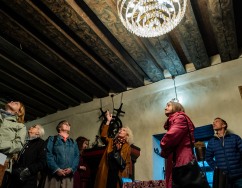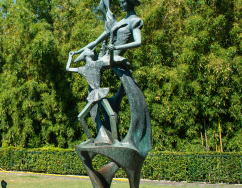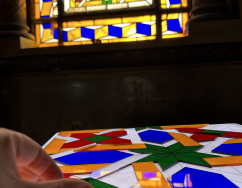European Heritage Days Article:
The Role of Women in Traditional Livestock Farming Explored with a Grant from EHD Stories
European Heritage Days Article:
The Role of Women in Traditional Livestock Farming Explored with a Grant from EHD Stories
One of the European Heritage Days Stories to receive a grant in 2024 was ‘Echoes of Tradition’ – a story from Greece looking at the cultural identity of transhumance communities who practice traditional pastoral farming. This article looks at how the funds were used to develop an exhibition and conference to further explore and raise awareness of this living heritage.
The European Heritage Days Story
The originally submitted ‘Echoes of TraditionStory explained the aims of Ecomuseum Zagori to preserve and promote the cultural identity of transhumance practices – a traditional farming method which involves the seasonal movement of livestock between grazing grounds. Over ten days, a group of participants immersed themselves in the customs of transhumance through lectures and workshops to reconstruct a hut which would have once been used to provide temporary shelter.
Goals for the project activities
The grant from the European Heritage Days Stories initiative was used for further activities to raise awareness about the cultural significance of transhumance. This included a conference which brought together academics, breeders, community leaders and cultural representatives such as shepherds and artisans as well as a multimedia exhibition available to visit in-person and online. These outputs aimed to explore transhumance as a key aspect of the cultural identity of the region and particularly looked to celebrate the role of women in livestock management and cultural customs. Other aspects the project aimed to discuss were the ongoing significance of transhumance as a living heritage tradition, its pan-European relevance and its role in environmental sustainability.
Engaging with target audiences
The project placed a specific emphasis on the vital role of women in the preservation and transmission of cultural heritage, noting that they have historically been underrepresented in the understanding of transhumance traditions. Through a series of video interviews with those of different ages, women from the community shared their personal stories which were then featured in an exhibition to recognise their contribution and explore the changing nature of their role within transhumance practices over the years. Expressing pride in taking part, some of those interviewed attended this event with their families, while visitors gave positive feedback about the emotional depth of the interviews.
The project also aimed to connect with young people and encourage a sense of empowerment in their role to preserve their heritage. For example, one video in the exhibition featured the daily life of a transhumance family and highlighted the resilience of the younger generation in keeping these traditions alive as an enduring part of their lives. Outreach and engagement with this age group was also supported by using digital platforms such as social media, as well as linking transhumance to biodiversity conservation to help young people understand the legacy of their ancestors for both cultural and natural heritage.
Highlighting living, natural and shared heritage aspects of transhumance
Through storytelling and discussions, visitors were encouraged to see transhumance as a living practice, with the cultural richness of the traditions spotlighted throughout the activities. For example, a female artist from the Sarakatsani tribe created an artifact for the exhibition about memory and storytelling using materials which are connected to transhumance such as wool and wood. Titled, ‘The Dance’, the piece weaved together aspects of art, nature and society and reflected the importance of song and dance for marking significant moments in her life. Creative elements of transhumance culture were also demonstrated through a celebratory musical performance to conclude the conference.
The relationship between transhumance and the natural environment was another topic covered, noting transhumance as a model for sustainable agriculture and promoting wool as a sustainably produced material. Additionally, presentations by biologists at the conference focussed on the importance of transhumance for maintaining the eco-system balance of the natural landscape and providing a broader understanding of the practice to include its environmental significance.
As well as local customs, the project also aimed to contextualise transhumance traditions in Greece as part of a wider European heritage which reflects UNESCO’s inscription of the seasonal droving of livestock as part of the intangible cultural heritage of humanity across a wide geographical area. To achieve this the activities featured international success stories and included experts and collaborators from a number of countries to emphasise the project’s pan-European relevance. An exchange with a nature conservation organisation in Turkey also fostered cross-border dialogue, enabling the sharing of experiences between communities and exploring shared cultural values across national boundaries.
Using digital platforms to increase reach
A key element of the project’s goals was maximising outreach to both local communities and also internationally. To do this, much of the project’s output was made available online and updates, behind-the-scenes content, interview clips and event highlights were promoted across several popular social media platforms. This digital strategy included making the exhibition available as a virtual experience, while the two videos produced for it were added to YouTube and have since been viewed over 22,500 times combined. It was also possible to watch the conference online via a live stream, which enabled more than 450 people to take part remotely or access the content afterwards which further amplified the project’s reach.
The future of the project
The online version of the exhibition is still available on the Ecomuseum Zagori website and continues to be enhanced with additional content. Through potential partnerships in Turkey, Spain and Italy it is hoped that the exhibition can now be adapted for a travelling version, while interactive workshops and presentations for schools and universities are being developed. Organisers have also had conversations with local government and policymakers about supporting transhumance-related initiatives, while interest from the media and researchers may lead to documentaries, publications and academic discussions further exploring the topic.
More information about the project, as well as the 3D virtual exhibition and videos can be found on the dedicated project page on the Ecomuseum Zagori website. The Museum can also be followed on Facebook and Instagram.


